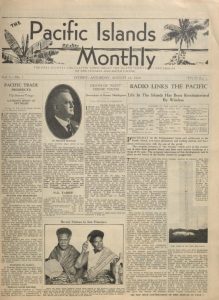Pacific Islands Monthly – digitised by the NLA and now in Trove!
 The National Library has recently completed the digitisation of the entire run of the Pacific Islands Monthly magazine and all of the issues can be browsed or the text fully searched on Trove, http://nla.gov.au/nla.obj-310385031.
The National Library has recently completed the digitisation of the entire run of the Pacific Islands Monthly magazine and all of the issues can be browsed or the text fully searched on Trove, http://nla.gov.au/nla.obj-310385031.
For more information, including tips on how to search PIM see:
http://www.nla.gov.au/blogs/behind-the-scenes/2017/03/10/pacific-islands-monthly-digitised
An excerpt by Julie Whiting follows:
The Pacific Islands monthly (PIM) was founded in Sydney by New Zealand born journalist Robert William (Robbie) Robson. The first issue was published August 1930 and it ran until June 2000.
PIM staff travelled throughout the Pacific seeking stories and building a network of contacts in business and politics. They were highly regarded by both expats and locals. The early volumes of PIM have a rather colonial perspective, with many of the articles about the administration and governance of the islands, the activities and people involved with this administration, and their views on the society, culture and economic future of the region. However, this in itself is very revealing and provides a unique glimpse into the attitudes of these Westerners, their governments, and the interactions with the local populations and indigenous political and tribal leaders. It is interesting to chart the change of focus of PIM during the later period of the magazine’s existence, particularly following the independence of various states, which shifted much more to general news, politics, business and investigative journalism.
PIM is an unrivalled source of information about current affairs, agriculture, transport, communications, local people and their life and customs, commodities, geography, climate, mining, sport and much more. PIM is also a wonderful means of tracking down elusive names, or seeing the emergence of particular people as they became important in island politics, business or society.
PIM is an unrivalled source of information about current affairs, agriculture, transport, communications, local people and their life and customs, commodities, geography, climate, mining, sport and much more. PIM is also a wonderful means of tracking down elusive names, or seeing the emergence of particular people as they became important in island politics, business or society.
Some of the articles are illustrated with exclusive photographs, and the cover images are always captivating.
Perhaps the most significant aspect of PIM is that it brings together information from all of the Pacific islands into a single publication. This makes it a highly valuable tool for researchers wanting to track particular issues or topics over the whole region and to compare and contrast the situation in various locations.
Advertisements are always a fascinating source of information, and those featured in PIM are no exception. As many PIM subscribers were Australian residents, some of the ads are just reproductions of those that would have appeared in other Australian publications. But many were aimed specifically at expats living in the Pacific, and also for local residents. These provide a wealth of information about the Australian companies that were marketing and exporting their goods to the Pacific and the diverse range of products supplied, from industrial products, to clothing, food, household goods, cosmetics, and educational services to name just a few. They are evidence of the importance Australian companies placed on the Pacific trade, with many specifically providing versions of their merchandise suitable or attractive for that market, and of the extent and long-standing nature of these commercial contacts. This might surprise people who think that Australian interactions with the Pacific were more of an administrative and colonial nature prior to the later 20thcentury.
Initially the ads were for Australian companies, but later issues included advertising from local Pacific companies – demonstrating the growth of local manufacturing and commercial enterprises. It is also instructive to note the changing nature of the advertisements, with those from the earlier period geared more towards personal products and general merchandise, and later the balance shifting to goods such as vehicles, financial/banking services, tourism and import/export companies. This is a reflection of the changing relationship between Australia and the Pacific region as the islands became independent, economies changed, and local businesses became more established.
There is such an amazing wealth of information in PIM, these are just a few topics to whet your appetite and provide a hint of the riches you can uncover and how to find them.
Take the opportunity to explore this magnificent resource by either browsing through the issues looking for unexpected gems, or searching for particular people, places or topics. Endless hours of pleasure and edification await you!
Julie’s tips for searching Pacific Islands Monthly are included towards the end of this article at: http://www.nla.gov.au/blogs/behind-the-scenes/2017/03/10/pacific-islands-monthly-digitised



